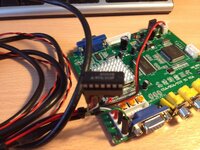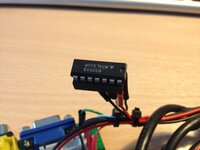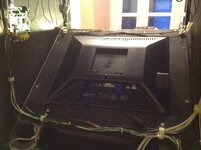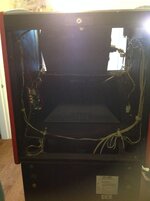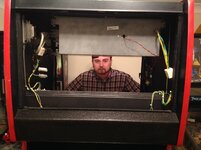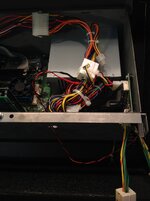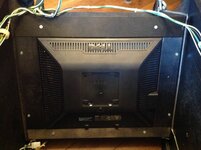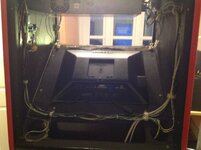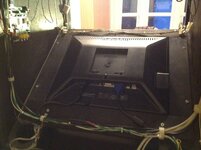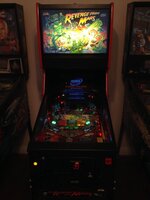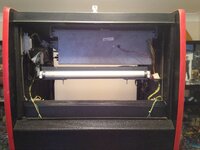Hi all,
I have spent hours looking everywhere for the diagrams to make a sync adapter for my RFM so I can fit an LCD screen. I have finally done it and got it working, so thought I would share it here.
I bought a cheap cga to vga converter off ebay first - shown in the pic. You will then need a vga monitor cable and a 74ls02 chip to convert the H&V sync to a combined sync. I used a Dell 19" LCD computer monitor I had lying around.
First job cut off one end of the VGA cable and strip back the wires. You will need to find the red, green, blue, horizontal sync wire(usually grey) and the vertical sync wire(usually white). All the ground wires can be twisted together. sleeve each of the wires with heatshrink.
Next solder the red, green, blue and ground wires to the respective pins on connector P3 on the board.
Now for the 74ls02 chip. You only need pins 1,2,3,7 and 14. Solder the Horiz sync wire(grey) to pin 2 the vert sync wire(white) to pin 3. Pin 1 is the combined sync ouput and a wire from pin 1 goes to the pin marked 'S' on connector P3. Add a wire to pin 7 for ground and a wire to pin 14 for +5v. This power can be got from within the p2k PC case. Don't forget the board also needs +5v power so just tee together the power leads then off to the pc case for your supply
That's it!!! plug in your new lead to the p2k PC monitor socket and put another lead between the vga socket on the adapter (P4) and your monitor and off you go. Mine worked first time so good luck!!!
Will add more to this when I actually fit it into the RFM.
Feel free to ask any questions.
Kev
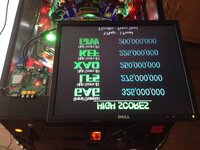
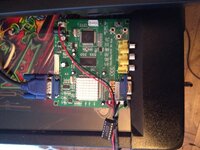
I have spent hours looking everywhere for the diagrams to make a sync adapter for my RFM so I can fit an LCD screen. I have finally done it and got it working, so thought I would share it here.
I bought a cheap cga to vga converter off ebay first - shown in the pic. You will then need a vga monitor cable and a 74ls02 chip to convert the H&V sync to a combined sync. I used a Dell 19" LCD computer monitor I had lying around.
First job cut off one end of the VGA cable and strip back the wires. You will need to find the red, green, blue, horizontal sync wire(usually grey) and the vertical sync wire(usually white). All the ground wires can be twisted together. sleeve each of the wires with heatshrink.
Next solder the red, green, blue and ground wires to the respective pins on connector P3 on the board.
Now for the 74ls02 chip. You only need pins 1,2,3,7 and 14. Solder the Horiz sync wire(grey) to pin 2 the vert sync wire(white) to pin 3. Pin 1 is the combined sync ouput and a wire from pin 1 goes to the pin marked 'S' on connector P3. Add a wire to pin 7 for ground and a wire to pin 14 for +5v. This power can be got from within the p2k PC case. Don't forget the board also needs +5v power so just tee together the power leads then off to the pc case for your supply
That's it!!! plug in your new lead to the p2k PC monitor socket and put another lead between the vga socket on the adapter (P4) and your monitor and off you go. Mine worked first time so good luck!!!
Will add more to this when I actually fit it into the RFM.
Feel free to ask any questions.
Kev



